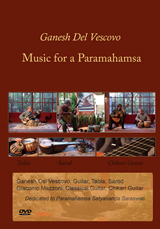A WORD ABOUT THE RAGA

A few considerations made by the guitarist and composer Ganesh Del Vescovo on the occasion of several concerts in which he played his own compositions using the Raga as a basis for the development of the pieces.
Ragas are part of the great tradition of classical Indian music and it is very difficult to explain what a raga actually is! However I shall try to give a few suggestions about some very simple aspects of the raga in order to help to understand what it is and how it is developed.
I shall begin by quoting the great Indian Sitarist Ravi Shankar :
“There is a saying in Sanskrit – “Ranjayati iti Ragah” – which means, “That which colours the mind is a raga.” As a blank canvas can be covered with colours and forms, so the receptive human mind can be “coloured” or affected by the pleasing and soothing sound of a raga. The beauty of the raga leads the listener to a serene and peaceful frame of mind and brings him joy. In other words, the raga must create a forceful effect on the listener. Every note in our musical system not only is a tone, but also carries within it a certain expression or emotion. The total expression of the notes and theme of a raga create an intensely powerful musical entity. Because of the nature of the notes – considered both as musical tones and as representations of ideas – it could never be said that a musician “invents” a raga. Rather, a raga is discovered (…) The number of possible ragas is nearly infinite.” (…) “For the Westerner who is unfamiliar with the complexities of our music, it is perhaps better first to explain what a raga is not, before defining it in detail. The raga should not be mistaken for a scale or a mode or a key or a melody, although it has affinities with each of these. A raga is the melodic framework, established by tradition or born and inspired in the spirit of a master musician.” (from “My Music, My Life” by Ravi Shankar –Publ. by Vikas, Delhi).
Having said this and leaving out technical details, I shall try to outline what I am going to play this evening. Like every raga, this one is associated with a particular mood, an emotion or passion and is related to a definite time of day and to a season. The raga which I am going to play is called Bhairavi. It is a morning raga but it has a peculiarity which allows one to introduce intervals belonging to other ragas, so it can be played it at any other time of the day. Please remember that ragas are developed mainly through improvisation. This improvisation is done by using definite intervals which are related to a basic drone note. The raga begins with an Alap which is the exposition of the raga itself. This movement is a slow and peaceful moment, a free and meditative invocation, without any form of rhythm. It represents the most important part of the raga during which one explores the sound, the mood and all the elements which will be developed later. The Alap describes the “personality” of the raga by indicating its tonal centres and defining its main phrases of expression. It is followed by the Jor. Here the first pulsation of rhythm is introduced; the elements used in the Alap are transformed through rhythm, but do not yet use strict rhythmic cycles. The raga grows in speed and becomes more intricate. At this point the percussions usually enter, but I shall be using a style without any percussions. Instead I have composed a Fantasia, a fantasy, on Bhairavi. The raga ends with the Gat. Here the rhythm is very precise and the theme used is usually handed down by a master. The music gets faster and faster and the raga finally culminates at maximum speed, accompanied by the continuous repetition of the drone notes; this makes is seem as though all these sounds unite to create one, unique, enrapturing sound.
Ganesh Del Vescovo – Florence – November 2005
 Italian
Italian English
English



